Appendix 1: Foundation Programs aims and progress for 2017

1. DEEP-EARTH FLUIDS IN COLLISION ZONES AND CRATONIC ROOTS (TARDIS II)
Themes 1, 2 and 3, Early Earth, Earth's Evolution and Earth Today, contributing to understanding Earth's Architecture and Fluid Fluxes.
AIMS
This program investigates the role of fluids in the deep mantle and lithosphere, using studies of kimberlites and other volcanic rocks, xenoliths of mantle and crustal rocks in volcanic rocks, ophiolites, and ultra-high pressure terrains related to subduction zones. Super-reducing, ultra-high pressure (SuR-UHP: 400-600 km) mineral assemblages in some ophiolites carry implications for the evolution of fluid compositions, reactions and redox states in subduction environments from the surface to the Transition Zone, and suggest a newly recognised geodynamic collision process that may improve mineral exploration concepts for paleosubduction regimes. The recent discovery of similar exceptionally reduced mineral assemblages in ejecta from Cretaceous volcanoes in Israel suggests a previously unrecognised process of interaction between deep mantle fluids and ascending basaltic magmas. We aim to produce an experimentally testable model for the generation of such fluids in the mantle, to quantify constraints on the geochemical and tectonic processes that produce SuR-UHP assemblages, and to formulate a geodynamic model for their formation.

2017 REPORT
A comprehensive investigation of microstructures and mineralogy in Tibetan ophiolites has defined their evolution, including formation in ancient SCLM within subduction-zone settings, followed by subduction into the upper transition zone and exhumation to the sea floor prior to final emplacement by thrusting during continental collision. Studies of ophiolites in Mexico have revealed similar recycling processes, though not extending all the way to the transition zone.
Dr Hadi Shafaii Moghadam continued his investigations into the portion of the Tethyan Belt that lies in Iran, integrating field studies, petrology and isotopic geochemistry of granitoid rocks (as probes of the deep crust), volcanic rocks and ophiolites. The evolution of this ‘soft collision zone’ can then be compared and contrasted with the ‘hard collision’ between India and Asia, exposed in Tibet. The project has established a geochemical and geochronological framework, shown the existence of buried Archean-Paleoproterozoic crust in the east-central part of the orogeny, and defined major magmatic flare-ups (Neoproterozoic and Cenozoic) related to major collisions and subduction. Studies of the suite of highly reduced minerals in the ejecta from Cretaceous volcanoes in Israel (industrial collaboration with Shefa Yamim (A.T.M) Ltd. labs in Akko) led to the development of a model involving interaction of mantle-derived methane and hydrogen with basaltic magmas in conduits near the crust- mantle boundary. Detailed mineralogical studies included further TEM analysis, in collaboration with Prof Martin Saunders (CMCA, UWA). Analyses of microstructures and mineralogy have demonstrated that moissanite in the Israeli ejecta and in Siberian kimberlites has grown from carbon-rich Fe-silicide melts, immiscibly separated from silicate melts. This model offers a possible explanation for the wide range of Si isotopes in SiC analysed by SIMS (Perth and Beijing (courtesy of collaborator Professor Li Xian-Hua)). There are clear linkages between the silicide melts that have crystallised SiC and those found within the corundum aggregates found in the Israeli volcanics. Analysis of zircons from the different Cretaceous volcanic bodies revealed an unexpectedly long history of magmatism in the mantle beneath Mount Carmel, extending back to the Permian, and analysis of the distribution of zircon populations among the Cretaceous volcanos generated a map of the temporal and spatial evolution of the magmatic underplate beneath the region.
The work on other mantle rocks continued, with studies of pyroxenites from SE Australia, the Pannonian Basin in Hungary, Cabo Ortegal (Spain) and the Trinity ophiolite (California). Work continued on kimberlites and diamonds in Angola, Siberia and South Africa, including studies of conventional (S, C, O, N) and unconventional (Mg, Fe) isotopes. A major study on the petrography and Sr-C-O isotopes of carbonates in kimberlites worldwide produced consistent criteria for the identification of primary magmatic carbonates and elucidated their role in kimberlite petrology. Work on the deep crust and its reworking continued in China, with petrological studies of xenoliths and adakites, and geophysical imaging.
See Research highlights:
Southwestern Africa on the burner
Distinctive aberrant geochemical fingerprints for Ancient SCLM in collision zones,
Pyroxenite layering in the upper mantle and how to find it,
Mapping the basaltic underplate: plume-related zircons from Mt Carmel,
Published outputs for 2017
CCFS publications: #628, 825, 835, 856, 862, 863, 864, 875, 878, 880, 933, 936, 942, 959, 965, 968, 969, 972, 975, 991, 998, 1001, 1002, 1004, 1007, 1010, 1018, 1046, 1047, 1048
<25 Conference Abstracts

2. GENESIS, TRANSFER AND FOCUS OF FLUIDS AND METALS
Themes 2 and 3, Earth’s Evolution and Earth Today, contributing to understanding Earth’s Fluid Fluxes.
AIMS
This program embodies a holistic approach to ore deposit research, acknowledging that the genesis of mineral occurrences requires the conjunction in time and space of three main independent parameters: fertility, lithosphere-scale architecture, and favourable transient geodynamics. In this context, the integrated studies in this Flagship program address the critical link between metal source fertility and four-dimensional evolution of multi-scale fluid pathways that ensure efficient mass and fluid flux transfer between the mantle and the upper crust. Our studies test the hypothesis that the genesis of sizeable mineral deposits is the end product of self-organised critical systems operating from the scale of the planet all the way to the very focused environments where ore deposits can form. This Flagship Program is not commodity-focused but rather looks at the basic commonalities among various mineral systems to unravel the main constraints in the formation of ore systems.
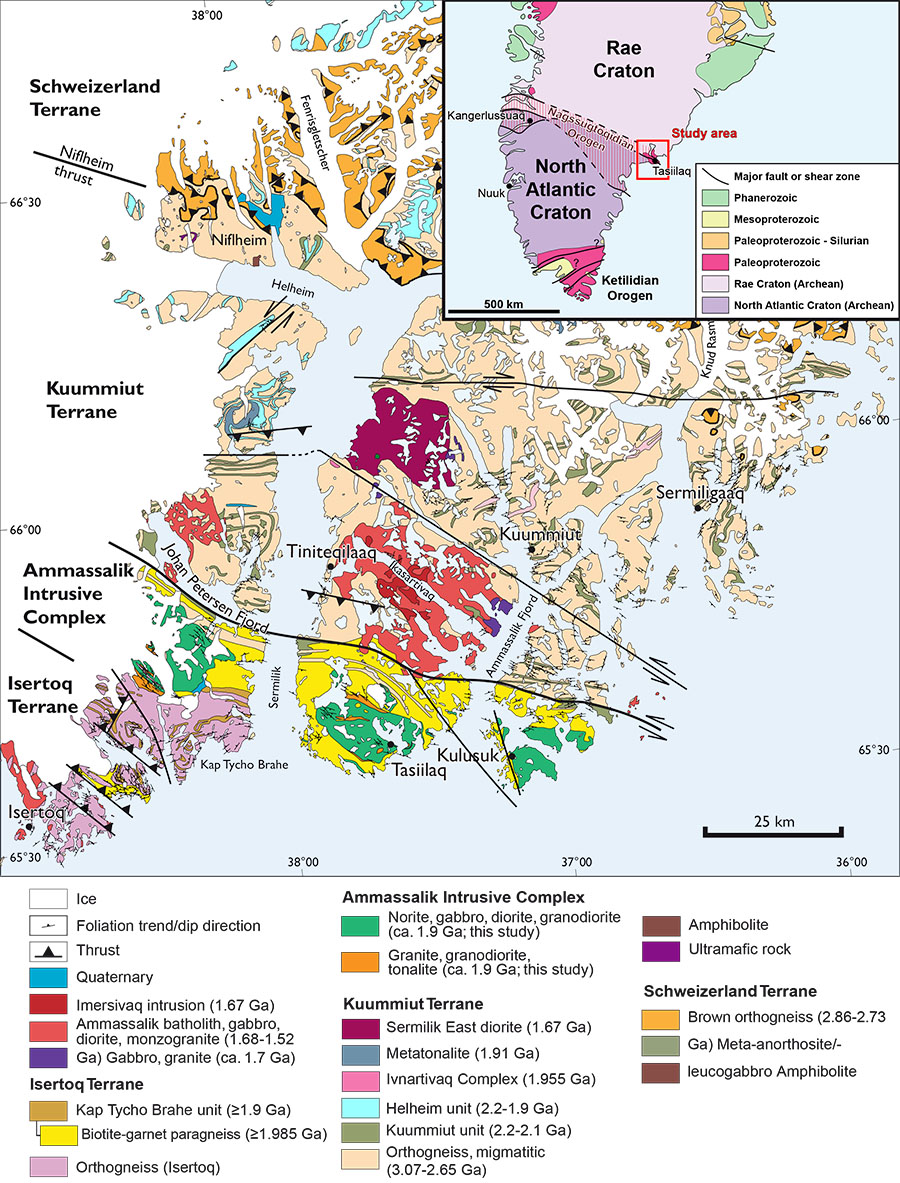
Figure 1.
2017 REPORT
In 2017, the ongoing integrated projects reached some important milestones. The projects in Module 1 (Fertility) focused on unravelling the global cycle of metals. Outcomes include the definition of a new calibrated oxybarometer that may be indirectly applied to discriminate the copper fertility of porphyry belts and unravel the secular oxygen fugacity evolution of the planet from the Hadean through the Eoarchean, as well as the definition of new fertility indicators for porphyry copper mineralisation based on the trace element composition of zircon. This work is fully integrated with other ongoing porphyry studies in South America and in the Macquarie Arc of New South Wales. Finally, from a fertility point of view, recent work completed in east Greenland suggests that nickel sulfide mineralisation associated with the Ammassalik Intrusive Complex (Fig. 1) may be genetically related to the highly endowed ca. 1.9 Ga Kotalhati belt in the Svecofennian Province of Scandinavia, thus opening up the prospectivity of that region for Ni-Cu intrusion- hosted deposits.
Ongoing projects in Module 2 (Architecture) have made significant progress in defining and imaging the key pathways that connect geochemical reservoirs and permit the efficient multi-scale flux of energy and fluids in space and time. Within Module 2, the high-precision TIMS work focused on the Kohistan Arc Complex of northeast Pakistan provided a refinement of current models describing continental crust formation in island arc settings, with crucial implications for the understanding of the architecture of magma plumbing networks in the lower crust.
Finally, in Module 3 (Transient Geodynamics), it was possible for the first time to couple recently produced solidii for carbonated basalts and sediments at pressures and temperatures relevant to upper mantle conditions with geodynamic modelling. This was accomplished through a robust thermomechanical and petrological modelling framework previously applied to decarbonation of subducting slabs and decarbonation within intracratonic settings.
See Research highlights:
Buoyant Ni-Cu-PGE-bearing magmas trapped deep in continental crust
Monitoring the evolution of gold-bearing fluids
El Dorado in El Indio Belt, Chile-Argentina
Zircon morphology, isotopes and the magmatic fertility of porphyry Cu-Au deposits
Porphyry Cu fertility in the Tibetan Plateau
Following the tracks of carbon in the upper mantle
New petrogenetic model for the adakitic magmatism of Patagonia and the Austral Volcanic Zone
Published outputs for 2017
CCFS Publications: #635, 846, 870, 879, 890, 926, 954, 955, 957, 973, 986, 988, 997, 1000, 1019, 1027, 1086, 1151
> 20 Conference Abstracts

3. MODELLING FLUID AND MELT FLOW IN MANTLE AND CRUST
Themes 2 and 3, Earth’s Evolution and Earth Today, contributing to understanding Earth’s Architecture and Fluid Fluxes.
AIMS
Many aspects of Earth Science, from ore deposits to giant earthquakes, depend critically on the complex interaction of solids and fluids. Numerical simulation of these processes and effective visualisations of the results is critical to understanding how these Earth system components work, but our ability to do this is currently very limited. Flagship Program 3 is developing the next generation of numerical codes and aims to refine the thermodynamic parameters involved by integrating high- pressure experiments to handle these complex problems. This will lead to important improvements in the quantification and visualisation of Earth processes, and will be applied to a variety of geodynamic situations.
The new high-pressure experimental group at Macquarie joins this initiative to provide input on physico-chemical parameters of minerals, melts and fluids in the deep mantle, the composition of melts that infiltrate the lithosphere, and their effects on its geodynamics and stability.
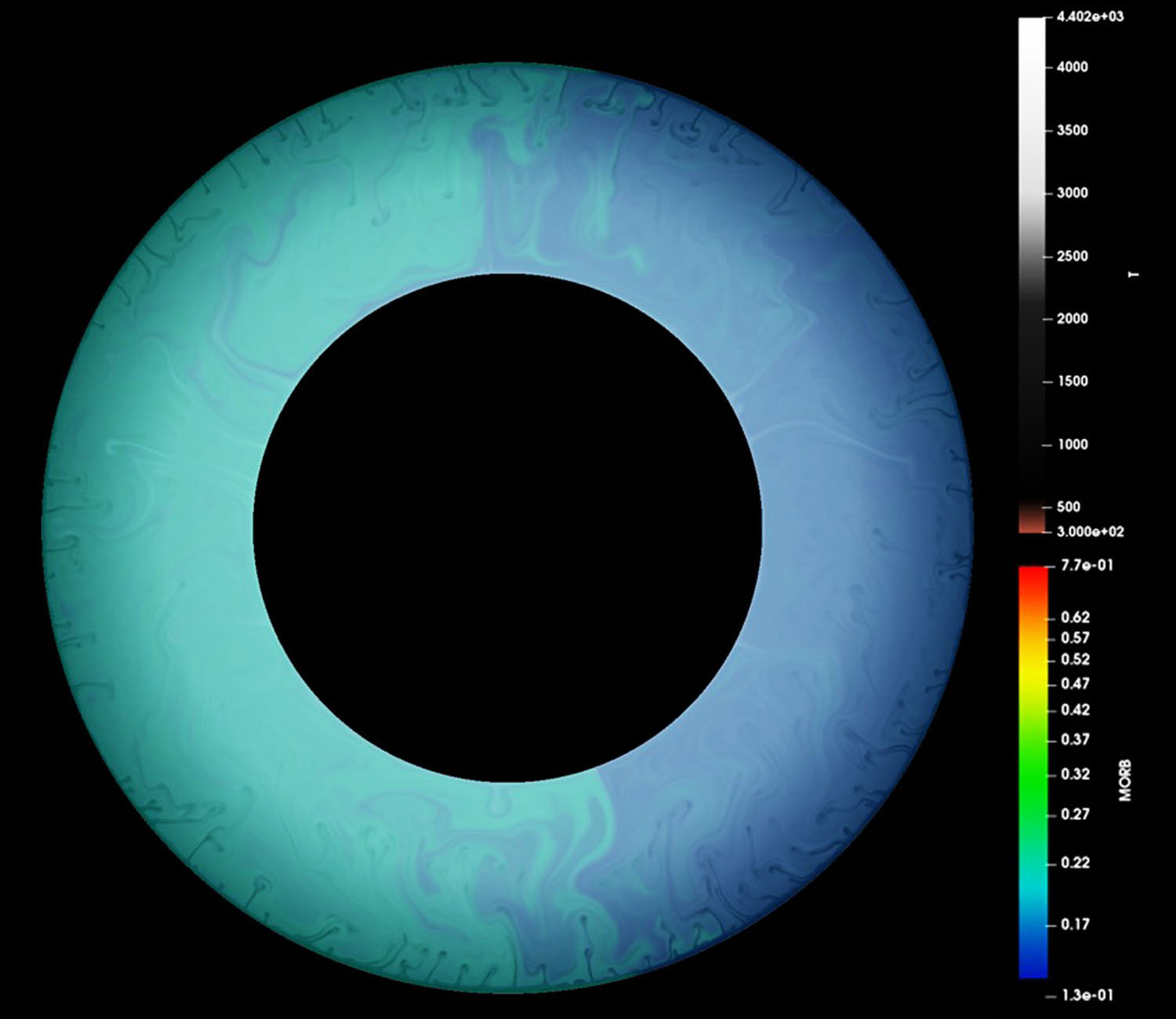
Figure 1. Simulation after 700 Myrs evolution, showing the survival of a primordial heterogenous mantle anomaly over that interval. The timescale is consistent with the survival of distinct Hadean 142Nd mantle reservoirs into the Eoarchaean.
2017 REPORT
2017 saw some of the final development implementations of fluid flow in the code Aspect implemented. This includes a sophisticated melt-transport capacity based on a statistical treatment of melt migration, allowing for melt emplacement and crustal production in global-scale simulations. These are now being implemented in simulations of continental lithospheric evolution, and flood basaltism. Many previously published physical implementations we have developed (e.g. magnetic field evolution, see dealii.org/aspect) have been rolled into the main Aspect community code, and other modules (e.g. impacting) are freely available for download. The latter module resulted in a Nature Geoscience paper, published in 2017, entitled “Impact-driven subduction on the Hadean Earth”. The material model implemented in Aspect has also been used to simulate the long-term survival of Hadean mantle reservoirs (observed from 142Nd data). The models show that despite a vigorous convecting regime, lateral variations in mantle composition may be sustained over periods of >800 Myrs, due to limited transfer of material between convecting cells in a stagnant-lid regime (Fig. 1). The work formed the basis of a Gordon Conference Keynote presentation, and is currently in review.
The development of a full multiphase flow methodology has resulted in a key paper outlining the approach in Geophysical Journal International (Oliveira et al., 2017). The underlying engine (LitMod) has also been applied to problems in dynamic topography of southern Africa, and in linking Pleistocene volcanism in Angola to a deep mantle upwelling.
The progression of the seismology arm of the project in China has led to a paper on the origin, and emplacement, of Quaternary volcanism in Northeast China, as well as further technical developments in, for instance, phase-velocity stacking.
The development and expansion of the high-pressure laboratory is underway, and building works and renovations have begun.
See Research highlights:
Southwestern Africa on the burner
A trapped fossil oceanic slab in NW China
Riding high on new wave model for southern California
CO2 released in continental rifts is “fried lithospheric diamonds”
Published outputs for 2017
CCFS Publications: #996, 1003, 1012, 1029, 1102 1118, 1119, 1152
15 Conference Abstracts

4. ATMOSPHERIC, ENVIRONMENTAL AND BIOLOGICAL EVOLUTION
Theme 1 Early Earth, contributing to understanding Earth’s Architecture and Fluid Fluxes.
AIMS
We investigate how the evolution of life and ore deposits were linked to the changing whole-Earth System, focusing on planetary driving forces that affected all the different shells of the planet, to develop a 4-dimensional conceptual framework of Earth evolution. Given the broadly comparable petrological evolution of Earth and Mars, we also aim to put forward new working hypotheses on how life and mineral systems may have formed and evolved on the red planet.
This program will test the hypothesis that the evolution of life and the genesis of sizeable mineral deposits are the end products of systems operating at the scale of the planet all the way down to the specific environments where life flourished and mineral deposits formed. We evaluate the relative importance of:
1) the threshold barriers that form in specific environments, creating strong chemical and energy gradients in the crust, and the self-organised behaviour of mineral systems and life;
2) the evolving nature of ‘traps’ at the lithosphere-hydrosphere boundary, where life and ore deposits developed through time;
3) the global-scale cycles of key elements and heat transfer essential for the evolution of life and formation of ore deposits and
4) the 4-D evolution of pathways that connect geochemical reservoirs through time, linked to the changing tectonic style of the planet.
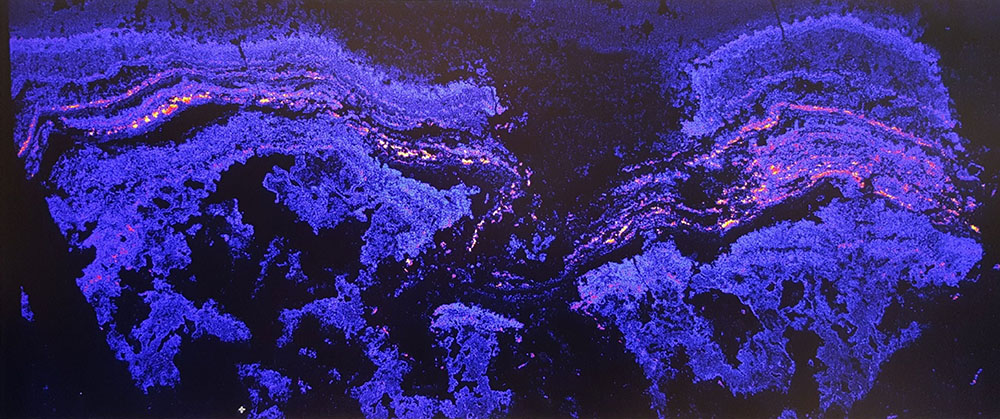
Figure 1. Australian Synchrotron X-Ray Fluorescence image of 3.48 Ga Dresser Formation pyritised stromatolites, showing Ni enrichment in thin laminae that wrap across individual branching structures. Width of view is ~1.5 cm.
2017 REPORT
In 2017, CCFS Flagship Program 4 was engaged in a wide range of research activities, from continuing investigations of the habitats and biogenicity of the earliest evidence of life on Earth, to the adaptation of life across the Great Oxygenation Event, and global tectonics. The publishing highlight was a Nature Communications paper by Tara Djokic on the discovery of terrestrial hot spring deposits that harboured microbial life in 3.48 billion-year-old rocks of the Pilbara Craton (see CCFS Communications p. 34). Raphael Baumgartner’s amazing work on tiny samples of drillcore material from the Dresser Formation stromatolites will be the new benchmark for definitive evidence of the oldest life on Earth (Fig. 1.). The work points to a new taphonomy involving microbial sulfidisation that is important in the search for ancient life on not only Earth, but elsewhere in the solar system. The work is being written up for publication in Nature. See Research highlight Sulfidised stromatolites from the Pilbara: A new benchmark for oldest life on Earth Early in 2017, three FP4 members participated in NASA’s 3rd landing site workshop, Los Angeles, for the upcoming Mars2020 mission to search for life on Mars. CI Van Kranendonk gave a presentation on why Columbia Hills, and hot spring sites in general, are good targets in this search, and helped to make this site one of the top three remaining in contention as the landing site for this exciting, $2Billion scientific experiment. A highlight of 2017 was the field trip to west Greenland with Martin Van Kranendonk, Allen Nutman (U. Wollongong), Darren Dougan (UNSW), and Clark Friend (self-funded) to map the area around the stromatolites discovered by our team and published in Nature in 2016. This field trip provided a more thorough geological context for the stromatolite discovery and located an additional outcrop, though these stromatolites were not as well preserved. It also confirmed the initial interpretation, that the stromatolites are bona fide signatures of microbial activity at 3.7 Ga. Mapping the area’s metamorphic fluid gradient identified areas where primary structures had been preserved, despite metamorphism and regional high strain. Most importantly, we identified a stratigraphy for the stromatolites, which showed a classic transgression sequence from pebble conglomerate at the base (lying on pillow basalts), through the stromatolitic carbonates interbedded with calc-silicates and quartz-rich sandstones, passing up into deep water facies iron-rich cherts. Another highlight was the discovery of unique branching siliceous structures in the 2.4 Ga Turee Creek Group that are of undoubted, but enigmatic, biological origin (See Research highlight Phosphorites - Older than you think!). These structures are the focus of the PhD study by Georgia Soares at UNSW and could well be the oldest evidence of eukaryotic life, in addition to complex microfossils discovered by Erica Barlow. Brendan Nomchong is looking into the environmental aspects of this reef in order to identify conditions that led to the flourishing of life at this time.
See Research highlights:
Origins of life: insights from the Pilbara
The oldest rocks formed by microbes: unexpected diversity
Sulfidised stromatolites from the Pilbara: A new benchmark for oldest life on Earth
Published outputs for 2017
CCFS Publications: #726, 855, 873, 956, 1070, 1075, 1133
11 Conference Abstracts

5. AUSTRALIA’S PROTEROZOIC RECORD IN A GLOBAL CONTEXT
Themes 2 and 3, Earth’s Evolution and Earth Today, contributing to understanding Earth’s Architecture.
AIMS
Earth’s history is considered to have been dominated by cycles of supercontinent formation and breakup. This program tests this hypothesis and its relevance to Australia’s geological evolution, assessing Australia’s positions during the supercontinent cycles by examining the paleomagnetic, petrological and detrital provenance record of the Australian and adjacent continents.
By studying primarily Australian rocks and comparing the results with global analogues, we aim to extend our knowledge about supercontinent cycles and the evolution of the Australian continent to the Paleoproterozoic or even further back in time. Such knowledge is fundamental for understanding the first-order fluid cycles that controlled the formation and redistribution of Earth resources, and the establishment of a 4D global geodynamic model covered in other Flagship Programs.
2017 REPORT
Research on the Yilgarn dyke swarms by two PhD students, Camilla Stark and Yebo Liu, have made breakthrough discoveries. In addition to the previously known dyke swarms of 2.4 Ga, 1.2 Ga and 0.75 Ga mafic dyke swarms, our work on newly identified 2.6 Ga, 1.9 Ga and 1.4 Ga mafic dyke swarms will provide key information for the evolution of the Australian continent and positions of the Yilgarn craton relative to other old cratons. Papers reporting on the age, geodynamic setting, palaeomagnetism, and a likely connection between Yilgarn and India at 1.9 Ga, are coming out in Precambrian Research (CCFS publications #1123 and #1068).
Palaeomagnetic analyses of the 1.8 Ga Hart dolerite from the Kimberley Craton also led to a new conceptual model of how the Proterozoic supercontinent Nuna was formed. In a paper currently under review, we propose that Nuna experienced a two-stage assembly process: between ca. 1.8 Ga and 1.73 Ga, Australia-East Antarctica was close to Laurentia but still separated by a relatively small ocean, and they appear to have shared similar plate motions. This small ocean only moved closed after 1.6 Ga, leading to the final assembly of Nuna by ca. 1.6 Ga. See Research highlight Supercontinent Nuna formed in two stages.
The northern Queensland team, supported by Li’s ARC Laureate Fellow project, is also starting to make breakthrough discoveries regarding Australia’s position in Nuna and Nuna’s assembly process. Provenance analysis of detrital zircons from the Georgetown region, led by PhD student Adam Nordsvan, revealed the first solid geological evidence for a connection between northern Australia and northwestern Canada in Nuna (CCFS publication #1043). The work shows that that the Georgetown terrane originated from North America, and only joined Australia at ca. 1.6 Ga during the final assembly of supercontinent Nuna. This work has generated huge global publicity. See Research highlight A piece of America lingers in northern Australia: Legacy of the 1.6-billion-year-old supercontinent Nuna.
A sedimentary provenance analysis of mid-Cambrian clastic rocks from the Ord Basin in north-western Australia gave surprise findings – the sediments were mostly derived from a non-Australian origin that bears similarities to northern India. This led to a revised palaeogeographic model in which clastic rocks from Indian Gondwana margin travelled along the north-eastern Gondwanan continental margin via longshore currents to northern Australia soon after the assembly of Gondwana.
In 2017, the first Neoproterozoic global reconstruction with full- plate topology was published through collaborations with the University of Sydney and the University of Adelaide, offering an exciting first glimpse into the future of paleogeography (CCFS Publication #925).
See Research highlights:
Published outputs for 2017
CCFS Publications: #790, 802, 840, 882, 883, 888, 897, 898, 920, 925, 952, 966, 985, 1011, 1033, 1043, 1068, 1123, 1131, 1134
28 Conference Abstracts

6. FLUID REGIMES AND THE COMPOSITION OF EARLY EARTH
Themes 1 and 3, Early Earth and Earth Today, contributing to understanding Earth’s Architecture and Fluid Fluxes.
AIMS
Zircon crystals are currently the only material that records events in the first 500 million years of Earth’s history, since no rocks have survived from this period and no other minerals have been established as Hadean in age. There is growing evidence from the study of these zircon crystals that the Earth stabilised rapidly after accretion and that both solid rock and liquid water were present within 150 million years of its formation. This program uses the geochemical signatures of zircon crystals from all known Hadean and early Archean localities, together with geochemistry of the oldest known rocks and the application of geophysical and geochemical modelling, to establish how the first crust formed, why it was destroyed, and the role fluids played in this process. The changes that took place throughout the Archean are being evaluated as crustal processes evolved and plate tectonics became the dominant regime. A key component is determining the interaction between the mantle and the evolving crust. In addition, work undertaken on Martian meteorites and lunar samples is providing further constraints on the early history of the Solar System, especially the role played by fluids.
2017 REPORT
CCFS post-doctoral fellow Dr Rongfeng Ge is re-evaluating the Jack Hills detrital zircon suite, focusing on identifying the most pristine portions in order to assess their original characteristics. Major advances include the recognition of radiogenic lead (Pb*) mobility on a nanometre to micron scale using ion imagining techniques. This led to the discovery of a concordant grain recording the oldest age known on Earth (4481+/-17 Ma), which nonetheless proved to be spurious due to Pb* mobilisation: the results were published in Geology. Other work published during the year included that of former CCFS PhD student, Dr Qian Wang, based on her traverse through the entire Jack Hills belt. A highlight of this study was the identification of a quartzite unit near the northern margin of the belt that contained ~20% Hadean grains. Work on the identification of CO2 and graphitic carbon inclusions in Jack Hills’ zircons, in conjunction with German colleagues, was also published.
The Nd study of 3.8-3.0 Ga TTG rocks from the Anshan area of the North China Craton (NCC) identified variations in 142Nd, suggesting evolution of the host rocks at c.a. 4.4 Ga. Work on the Kuruktag area of the Tarim Craton identified a tonalite recording an age of 3.7 Ga, making it one of the oldest rock-units in China: this work has been published in Science Advances.
Lu-Hf analyses were undertaken on samples from Aker Peaks in Kemp Land, Antarctica, to better characterise their age and provenance and the results are currently being evaluated. The metallic lead nanospheres identified in ancient zircons from the Napier Complex, Antarctica, have been investigated by both NanoSIMS and atom probe and work will continue into 2018.
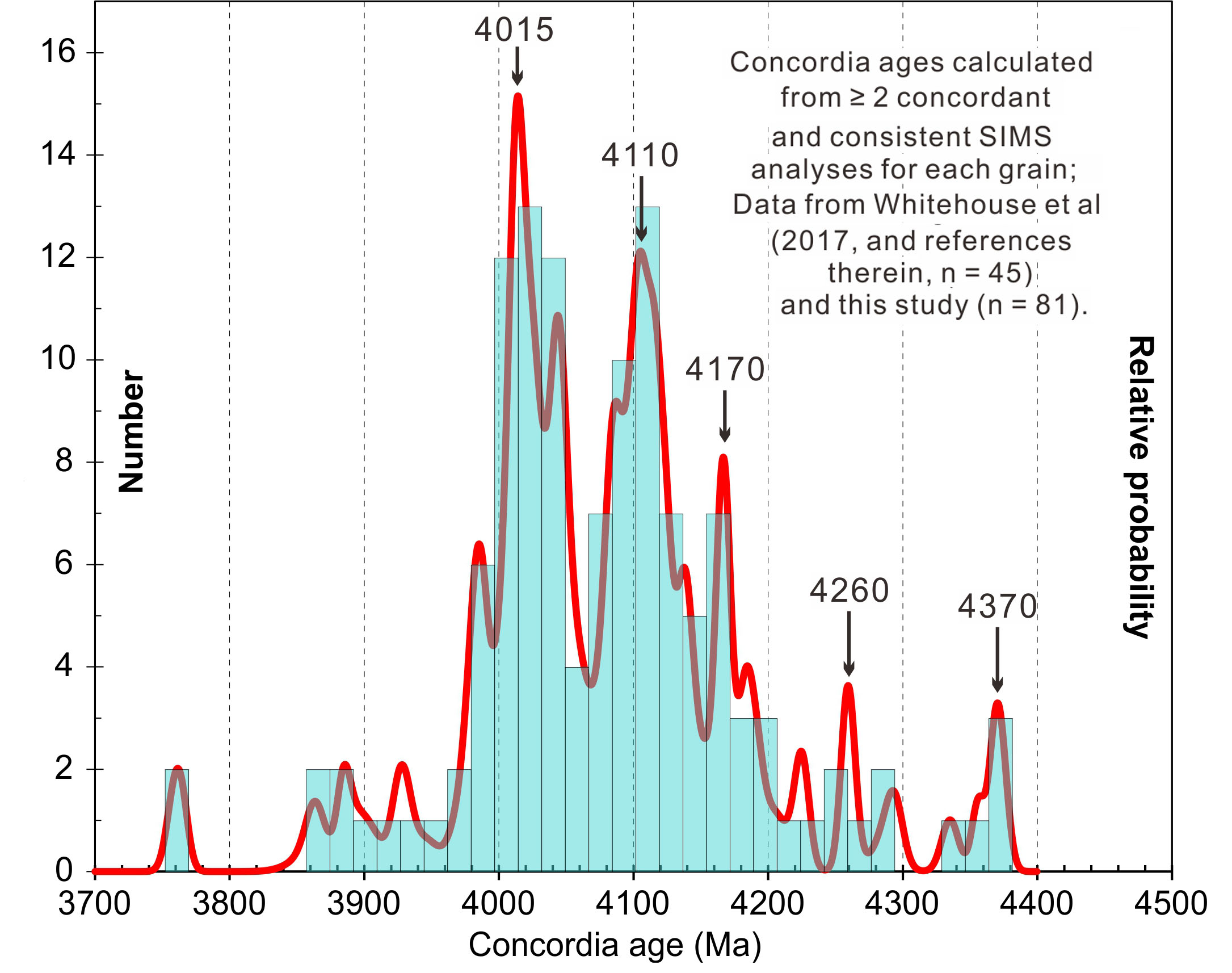
Figure 1. Compilation of all the available Concordia data from single zircon crystals, identifying the key age peaks within the Hadean.
A field trip was made to the Saglek Bay area of Labrador, Canada, to further investigate the ancient gneisses where vestiges of life at 3.9 Ga have been reported by Japanese scientists. Detailed studies were undertaken in several selected areas and a suite of 140 samples collected for geochemical and isotopic investigation in association with the Polish Academy of Sciences.
Further analysis of lunar basalts helped to revise the stratification of basaltic sequences at the Apollo landing sites and also helped in developing a reference framework for crater counting chronology. Analyses of millimetre-sized lithic clasts in lunar impact breccias demonstrated that their Pb isotope systems were completely reset during the impacts, hence providing a means of defining the ages of both the breccias and the impacts that formed them. Some basaltic clasts analysed in lunar meteorites and dated at around 4.33-4.36 Ga confirm for the first time that basaltic magmatism started on the Moon immediately after solidification of the Lunar Magma Ocean and basalts were not formed after ~3.8 Ga. A coherent Pb isotope evolution model of the Martian mantle was formulated that is consistent with the results obtained from other isotope systems, including Rb-Sr, Sm-Nd, Lu-Hf and Re-Os.

Ripple-marked sandstone in the Cuddapah Basin, India (See CCFS publication #1127).
Published outputs for 2017
CCFS Publications: #962, 963, 1087, 1111, 1116, 1120, 1127, 1128, 1130, 1131, 1132, 1137, 1138, 1139, 1140, 1142, 1143, 1144, 1145, 1146, 1147, 1148, 1149, 1156
9 Conference Abstracts

7. PRECAMBRIAN ARCHITECTURE AND CRUSTAL EVOLUTION IN WA
Themes 1, 2 and 3, Early Earth, Earth’s Evolution and Earth Today, contributing to understanding Earth’s Architecture.
AIMS
Iron, Gold and Nickel deposits are of global economic significance, and the Neoarchean Yilgarn Craton and the Proterozoic orogens around its margins constitute one of Earth’s greatest mineral treasure troves. Whereas the Yilgarn Craton is one of the best-studied Archean cratons, its enormous size and limited outcrop are detrimental to a deep understanding of what controls the distribution of resources and which geodynamic processes were involved in the tectonic assembly of the Australian continent. This program combines geological, geochemical and geophysical techniques to develop a 3D structural model of the lithosphere of the Yilgarn Craton and its margins. The Yilgarn Craton is a highly complex piece of Archean crust with a long history extending from 4.4-2.6 Ga: amalgamation of terranes is thought to have occurred around 2.65 Ga. The program includes the Capricorn Orogen Passive Array (COPA), a passive-source experiment that studies the structure of the deep crust and shallow lithosphere using earthquake seismology. The data from this experiment will be the main source for the local ambient noise inversion, the receiver function common convection point (CCP) stacking techniques, and possibly a body-wave tomography study. Given the fact that the passive source site coverage in Western Australia is sparse and that the available permanent sites in the region provide nearly 10 years of data at isolated locations, several techniques that focus on crust and upper mantle structure beneath single stations will also be applied. This approach has the potential to provide quick access to the crustal and lithospheric structure from these representative sites.
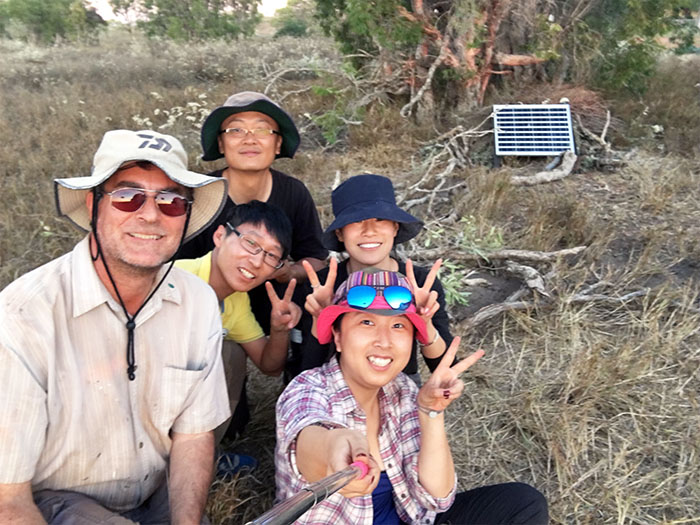
CWAS Team work: a selfie after finishing a portable seismic station at Wallal Downs, Canning.
2017 REPORT
We completed the Capricorn Orogen Passive-source Array (COPA) field deployment in late 2017, and data analysis is currently under way. In 2016, the data collected from previous services were analysed with a focus on the seismic structure of the Capricorn Orogen crust. The Canning land (CWAS; 20 sites) and ocean-bottom-seismic (CANPASS; 11 sites) arrays were successfully deployed in September 2017 in collaboration with the Institute of Geology and Geophysics of the Chinese Academy of Sciences (IGG-CAS). A 40-site Perth Basin Seismic (PBS) array started operation in 2017.
Recent work on the Hf isotopic composition of the unexposed Proterozoic crystalline basement to the Bight and Eucla Basins in Western Australia has revealed the existence of a huge tract of predominantly juvenile material. The observed isotopic evolution pattern is comparable to other central Australian Proterozoic provinces, including the Musgrave Province, the northern margin of the Gawler Craton, and components within the Rudall Province. New zircon Hf isotope and whole-rock Nd isotope data from the Pilbara Craton, Western Australia do not support a model of modern-style subduction, instead being consistent with vertical tectonic processes in a volcanic plateau-type setting for the East Pilbara Terrane prior to ~3.2 Ga. New zircon O, U-Pb and Hf isotope data from magmatic rocks across the Rudall Province outline two potential scenarios for the Paleo- to Mesoproterozoic geodynamic evolution of the Rudall Province. An early cratonic amalgamation between the West and North Australian Cratons ca. 1680 Ma followed by Mesoproterozoic intraplate events or, more likely, a later assembly ca. 1377–1275 Ma (Yapungku Orogeny).
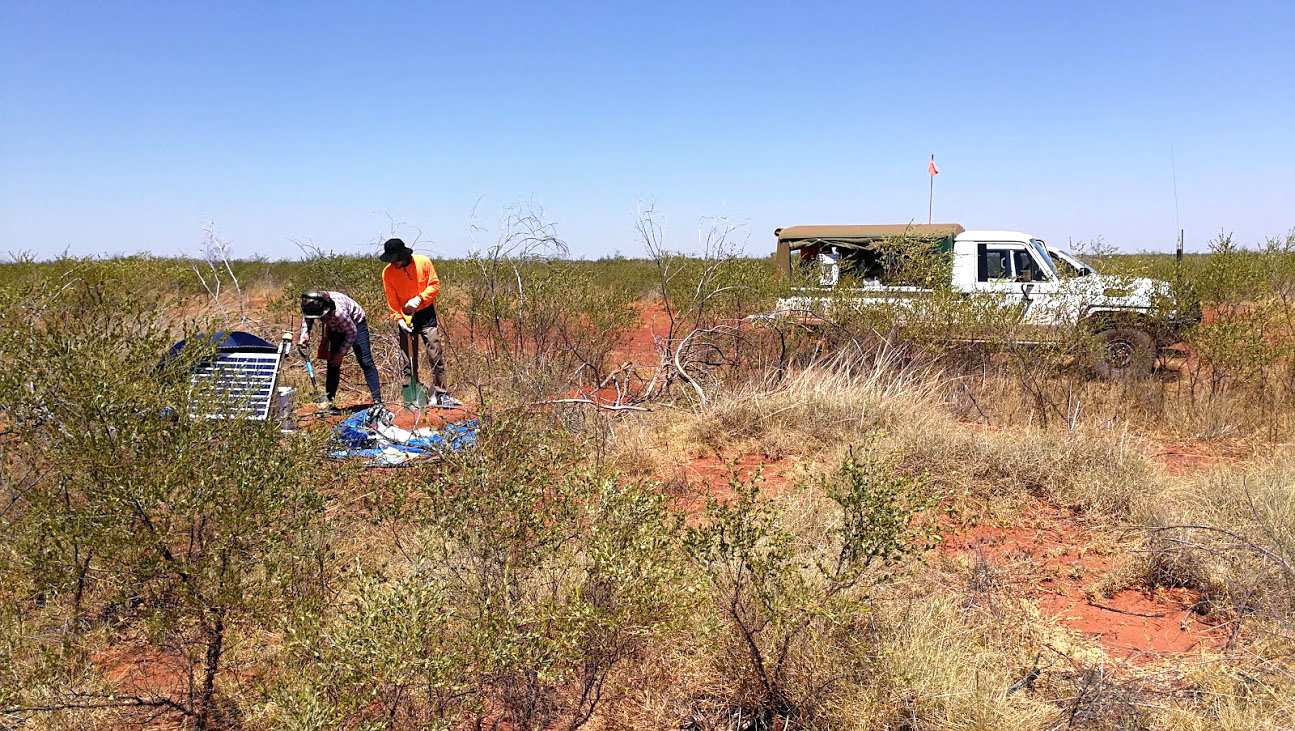
IGG-CAS visitors Kun Wang, and Baolu Sun install a portable seismic station at the abandoned airstrip of Anna Plains Station during the Sept 2017 CWAS deployment.
See Research highlights:
Crustal Evolution of the Albany-Fraser Orogen
Seismic image of the Capricorn Orogen – revealing the crustal component
Zircon signals mineralisation potential of Archean granites
Seismic image of the Capricorn Orogen – revealing the mantle component
Published outputs for 2017
CCFS Publications: #971, 1135, 1060, 1061, 1064, 1076
2 Conference Abstracts
WHOLE OF CENTRE TECHNOLOGY DEVELOPMENT

1. CAMECA ION MICROPROBE DEVELOPMENT: MAXIMISING QUALITY AND EFFICIENCY OF CCFS ACTIVITIES WITHIN THE UWA ION PROBE FACILITY
Themes 1, 2 and 3, Early Earth, Earth’s Evolution and Earth Today, contributing to understanding Earth’s Architecture and Fluid Fluxes.
AIMS
The Ion Probe Facility within the CMCA at UWA is one of the best-equipped Secondary Ion Mass Spectrometry (SIMS) labs in the world. It houses a CAMECA IMS 1280 large-radius ion microprobe, for the high-precision analysis of stable isotopes in minerals, and two CAMECA NanoSIMS 50s for imaging mass spectrometry at the sub-micron scale. This program provides a dedicated Research Associate to facilitate CCFS activities and lead the development of standards and analytical protocols at the CMCA. This greatly benefits CCFS by increasing the capacity of the Facility, enabling a higher degree of interaction and participation on research projects, facilitating standards and protocols development, and allowing greater synergy with other CCFS node facilities. For progress in 2017 and plans for 2017, please see Technology Development

2. FRONTIERS IN INTEGRATED LASER-SAMPLED TRACE ELEMENT AND ISOTOPIC GEOANALYSIS
Themes 1, 2 and 3, Early Earth, Earth’s Evolution and Earth Today, contributing to understanding Earth’s Architecture and Fluid Fluxes.
AIMS
The overall aim is to develop new analytical methods for in situ measurement of trace elements and isotope ratios to support and enable CCFS research programs and to provide new directions of research. Specific objectives include:
(1) combined trace element and isotope analysis - ‘split-stream’ analysis
(2) development of ‘non-traditional’ stable isotopes
(3) characterisation of reference materials for elemental and isotope ratio measurement
(4) development of data reduction software for combined trace element and isotope analysis
For progress in 2017 and plans for 2017, please see Technology Development

 ARC Centre of Excellence for Core to Crust Fluid Systems
ARC Centre of Excellence for Core to Crust Fluid Systems